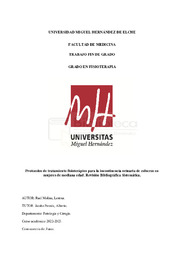Por favor, use este identificador para citar o enlazar este ítem:
https://hdl.handle.net/11000/30213
Protocolos de tratamiento fisioterápico para la incontinencia urinaria de esfuerzo en mujeres de mediana edad. Revisión Bibliográfica Sistemática.
Título :
Protocolos de tratamiento fisioterápico para la incontinencia urinaria de esfuerzo en mujeres de mediana edad. Revisión Bibliográfica Sistemática. |
Autor :
Rael Molina, Lorena |
Tutor:
Jarabo Pereda, Alberto |
Editor :
Universidad Miguel Hernández de Elche |
Departamento:
Departamentos de la UMH::Patología y Cirugía |
Fecha de publicación:
2023-06-05 |
URI :
https://hdl.handle.net/11000/30213 |
Resumen :
Introducción: la incontinencia urinaria de esfuerzo (IUE) se clasifica como la más frecuente dentro de
los subtipos de incontinencia urinaria. Su prevalencia es significativa en mujeres de mediana edad y su
mecanismo fisiopatológico es producido por un desequilibrio de fuerzas. La IUE puede tener... Ver más
Introduction: stress urinary incontinence (SUI) is classified as the most common of the urinary
incontinence subtypes. Its prevalence is significant in middle-aged women and its pathophysiological
mechanism is produced by an imbalance of forces. SUI can have physical, psychological and social
effects.
Objectives: to analyze different physiotherapy treatment protocols for SUI and to determine which one
has significant results in terms of frequency of leakage, muscle strength gain and quality of life.
Material and methods: we searched for clinical trials published from 2013 onwards in the Pubmed,
Scopus, Web of Science and PEDro databases. Trials in any language were included.
Results: 18 total studies analyzed different types of treatment such as pelvic floor muscle training
(PFMT) alone and in combination, Kegel exercises, biofeedback or lumbo-pelvic exercises among
others. Statistically significant results were obtained in at least one measure analyzed, in trials using
PFMT in isolation and in combination with another type of treatment. The main outcome measures were
decreased frequency of leakage, muscle strength gain and improved quality of life compared to baseline.
Conclusion: there is evidence that PFMT treatment has positive effects, but there is still a lack of
research on the optimal treatment and parameters that are most effective for SUI.
|
Palabras clave/Materias:
fisioterapia
incontinencia urinaria de esfuerzo
protocolos de tratamiento
mujeres de mediana edad |
Área de conocimiento :
CDU: Ciencias aplicadas: Medicina: Patología. Medicina clínica. Oncología |
Tipo de documento :
info:eu-repo/semantics/bachelorThesis |
Derechos de acceso:
info:eu-repo/semantics/openAccess |
Aparece en las colecciones:
TFG - Fisioterapia
|
 La licencia se describe como: Atribución-NonComercial-NoDerivada 4.0 Internacional.
La licencia se describe como: Atribución-NonComercial-NoDerivada 4.0 Internacional.
 La licencia se describe como: Atribución-NonComercial-NoDerivada 4.0 Internacional.
La licencia se describe como: Atribución-NonComercial-NoDerivada 4.0 Internacional.
.png)
